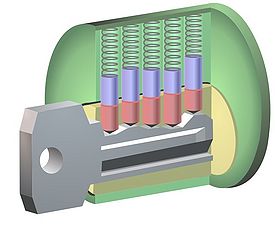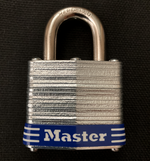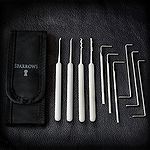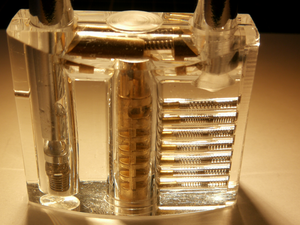Begin pin tumbler
|
Getting Started
|
Next Steps
|
Resources
|
|
Beginning Pin Tumbler Picking
CommunityLocksThis is where we talk about selecting and sourcing locks for beginning practice. Although there seems to be a lot of people beginning their lockpicking training on padlocks, cheap double euro cylinder can be a better choice; by sawing it in halves, you get two training locks. Gut them (just watch for the skeletonized cores!) and you can progressively pin them to learn your way around the keyway. This also saves you pain of learning security pins right at the beginning - just use standard drivers at the start and start adding security pins into the mix when you are ready.
ToolsTo begin to learn Single Pin Picking (SPP), at least two tools are needed: one to manipulate the pins and one to rotate the lock plug. A pick with a hook profile is often recommended for SPP. It is generally recommended to use a turning tool that fits in the keyway without blocking access to the pins while still providing feedback and control of the rotation. Listed here are a few suppliers where hobby lockpickers frequently buy these tools
It is easy to make some tools yourself
Other usefull stuff
PracticePractice Locks
ExercisesThe following section provides exercises to help new lock pickers develop their new skills. Like with many other activities, it's recommended to learn good habits from the start instead of unlearning bad habits later. These exercises try to support such a good start. Angling the lock pickThe lock pick often needs to be angled to navigate the lock smoothly. The general idea is that you can move the pick around in the lock without scraping the sides of the pick against the lock, as this can take useful feedback away. This often means the pick needs to be angled clockwise or counterclockwise a few degrees.
Typically the pick requires an angle of 5 or 10 degrees. Also, in general, pins need to be manipulated without disturbing other pins. This generally means the back of the pick should be as far away from the pins as possible, while the tip is able to manipulate one pin at a time.
It is possible that the angles differ by even 90 degrees. Note that the pins in the back of the lock require a significant smaller angle. Feeling where you areWhile lock picking it is generally important to know which pin you are touching and, perhaps more importantly, to know if you are touching a pin. One reason picks break with beginners is that by accident the lock itself is pushed by the pick instead of the pin. An excersise that can help with knowing where you are is the following:
PickingTool CheckDisassembly
OR
BooksThis is where we mention some books, like https://nostarch.com/locksport or Little Black Book of Lockpicking: Lock opening and Bypass techniques for Security Professionals. |



